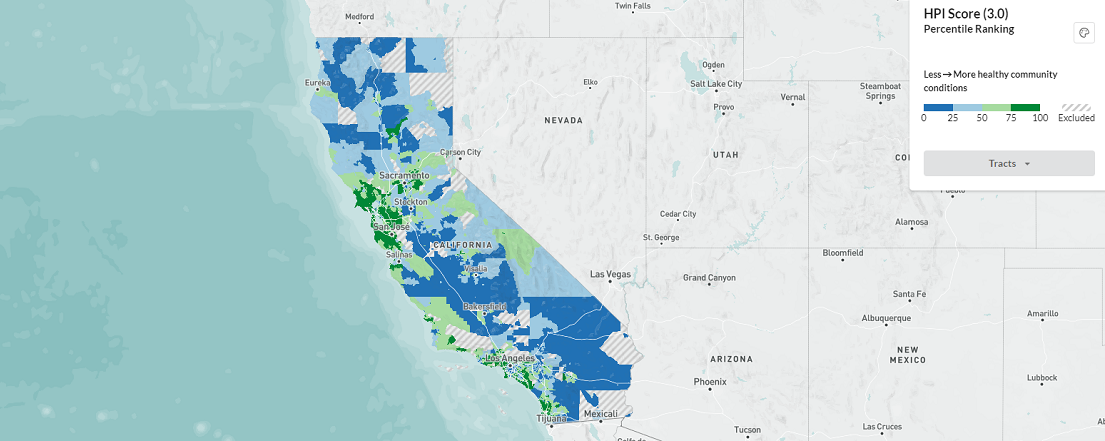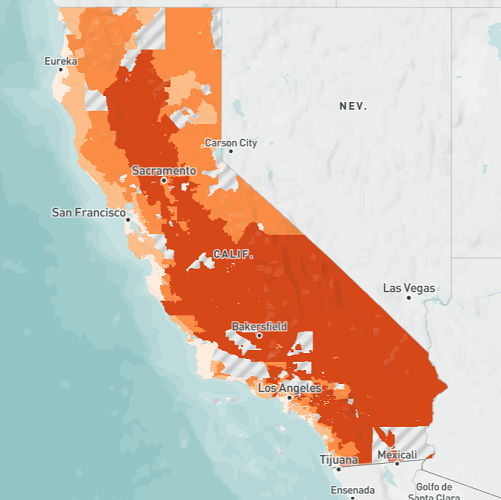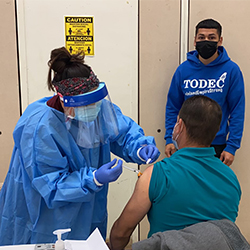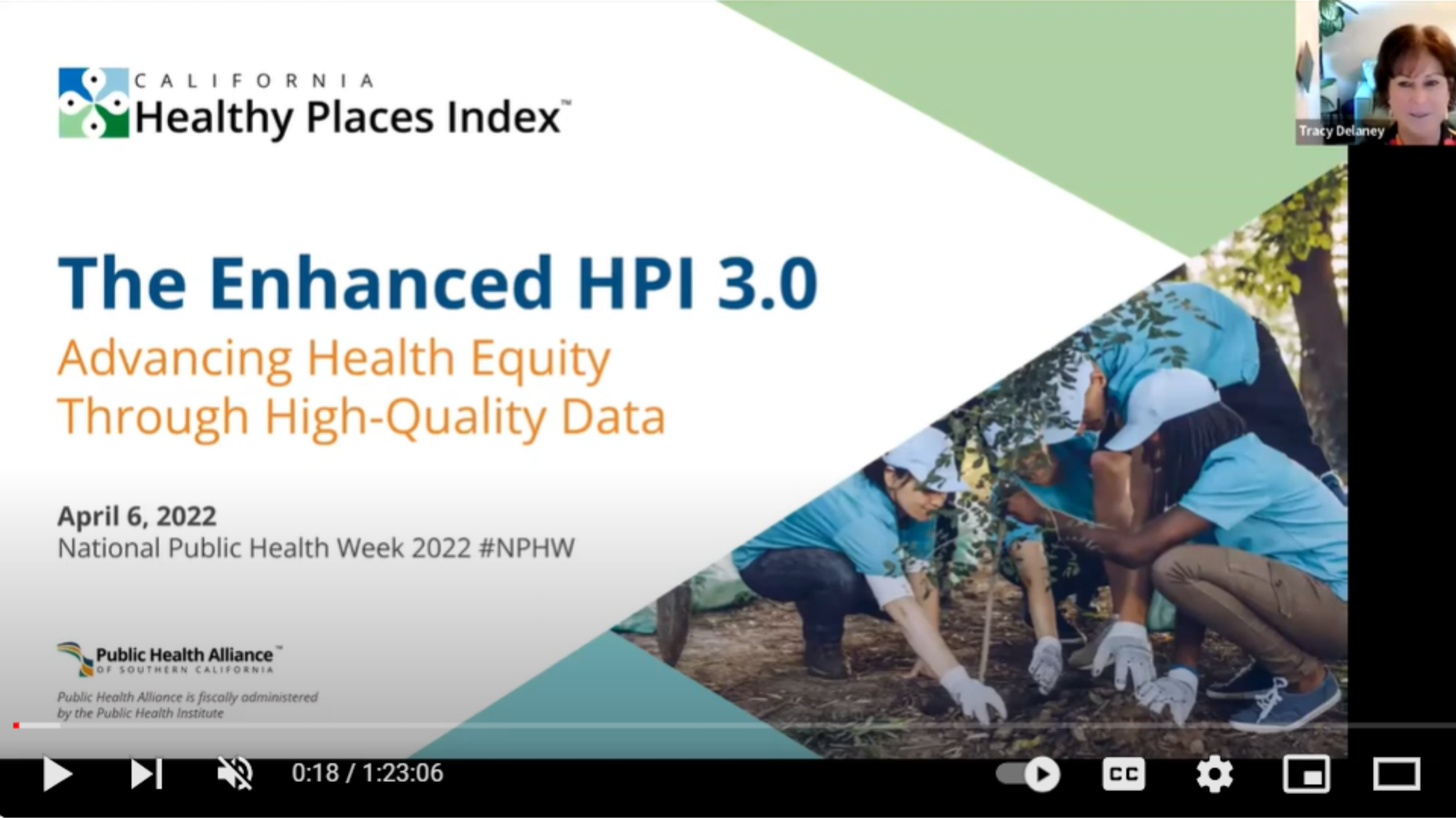
The Healthy Places Index (HPI)
-
Focus Areas
Data, Technology & Innovation, Health Care & Population Health, Healthy Communities -
Issues
Nutrition & Food Security, Population Health, Wildfires & Extreme Heat -
Programs
Healthy Places Index (HPI), Public Health Alliance of Southern California -
Strategic Initiatives
COVID-19, Vaccine Access & Equity

The Healthy Places Index (HPI), a resource developed by the Public Health Alliance of Southern California, is a powerful and easy-to-use data and policy platform created to advance health equity through open and accessible data.
The HPI is evidence-based, peer-reviewed, and supports efforts to prioritize equitable community investments, develop critical programs and policies across the state, and much more.
Visit the HPIThe HPI map offers robust features, allowing users to view and compare HPI scores and community conditions across multiple geographies; prepare detailed reports with score dashboards, map snapshots, and policy actions; pool HPI data into custom geographies; and more. The tool is highly interactive and customizable, and even includes policy solutions to help turn information into action. Learn more in this webinar recording from the HPI 3.0 launch:
HPI’s Race and Place Framing
Everybody deserves the opportunity for a long and healthy life, regardless of who they are or where they call home. However, we know that access to these opportunities is not equal across communities.
Where we live and the historic legacies of racism and discrimination experienced by communities of color—our racial and ethnic backgrounds—are strongly tied to measures of well-being and life expectancy—even more so than genetics. Decades of research have demonstrated how health outcomes are strongly tied to neighborhood environments and community conditions, which are, in turn, strongly linked to race. We also know that conditions that support health, such as access to education, good job opportunities, and clean air and water—vary drastically by neighborhood.
PHI’s Public Health Alliance of Southern California created the HPI on the premise that lasting systems change cannot occur unless leaders, community providers, advocates and even residents themselves understand the critical relationship between place, race, and a person’s health outcomes.
In other words, both race and place need to be measured simultaneously, to examine and address the real-life, day-to-day impacts of structural racism.
- Offers more nuanced insights on the specific needs and conditions of each community.
- Provides sound, quality data for residents, advocates and leaders.
- Helps communities better advocate for their unique needs.
- Guides leaders to develop more equitable, community-forward solutions.
- Allows leaders and community providers to scale resources appropriately for each region.
- Ensures that health and racial equity are baked into the data.
But we know data alone is not enough to dismantle the legacy of racially driven policymaking. Our data works at its best when supporting the lived experiences and strengths of the communities at the forefront of social change.
Ultimately, the HPI data and policy recommendations are meant to support leaders and advocates to prioritize investments, resources, and programs in the neighborhoods most disproportionately impacted by health and racial inequities.

Using HPI to Map Who & Where in CA Will Be Most Impacted by Extreme Heat
The Healthy Places Index: Extreme Heat Edition (HPI: EHE) allows community groups, government entities, schools, tribal organizations, community members and other key audiences to scan their community and understand which areas and populations will be most affected by heat this season and in the years to come. They can also determine what protections/interventions are most needed to address these challenges. The tool was developed by the Public Health Institute’s Public Health Alliance of Southern California in partnership with the UCLA Luskin Center for Innovation.
“Open and accessible data on extreme heat impacts, linked with opportunities and funding sources, is key to empowering communities to build healthy, resilient neighborhoods. The California HPI: Extreme Heat Edition makes these data actionable through an interactive, easy-to-use tool,” said Tracy Delaney, PhD, the founding executive director of the Public Health Alliance of Southern California.

Explore: COVID-19 HPI Resource Map
To support the efforts of local leaders, schools, government agencies, foundations, and neighborhood organizers during this crisis, and to ensure resources are being directed toward communities which have been disproportionately impacted by the pandemic, we launched an interactive update to our established platform: the Healthy Places Index (HPI).
The tool looks at 48 unique COVID-19-related indicators, organized into six categories, to support your organization’s COVID-19 response strategies. Categories include: COVID-19 vulnerable populations, COVID-19 associated health risk factors, healthcare infrastructure, as well as socioeconomic and community conditions. With the latest update, you can explore vital conditions linked to life expectancy across California with up-to-date COVID-19 data, including county-level death rates by race/ethnicity (where available).
HPI Ethical Use Guidelines
Why Ethical Use Matters
The ethical use of the HPI is a commitment to fostering positive change in a responsible and inclusive manner. These guidelines are born from our conviction that data, when harnessed ethically, can be a force for good. It is our shared responsibility to ensure that the HPI serves as a catalyst for equitable health improvements, inspiring actions that uplift communities rather than perpetuate disparities.
- Promote equity: Use HPI to advance equity and improve community conditions that affect health.
- Choose small geographies: Use data at the neighborhood (census tract) level wherever possible. Larger geographies, like ZIP codes and counties, can hide important differences in community conditions.
- Ensure community engagement: Prioritize community involvement in the interpretation and application of HPI data, respecting local knowledge and perspectives to ensure that interventions align with the unique needs of each community.
- Invest in communities: Direct resources towards communities identified as priorities by the HPI, fostering positive change and sustainable development.
- Act on root causes: Promote equity by addressing upstream social drivers of health through evidence-based policy, systems, and environmental change, such as those recommended in HPI Policy Action Guides.
- Establish transparent decision-making: Communicate openly about how HPI data informs decision-making processes, promoting transparency and accountability in the allocation of resources and implementation of policies.
- Avoid stigmatization: Leverage HPI’s positive frame and asset-based language to empower communities, recognizing that the index is a tool for positive change rather than a basis for negative assumptions or harmful stereotypes.
- Model high standards: Whenever possible, use best data practices to explore community conditions and to create health equity metrics for health outcomes in public health and health care settings.
- Consider unintended consequences: Even well-intentioned applications of the HPI may have negative unintended consequences. Evaluate potential consequences that run counter to equity and consider community-informed strategies to minimize these consequences.
Work With Us
You change the world. We do the rest. Explore fiscal sponsorship at PHI.
Support Us
Together, we can accelerate our response to public health’s most critical issues.
Find Employment
Begin your career at the Public Health Institute.



